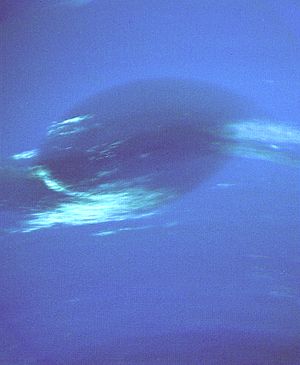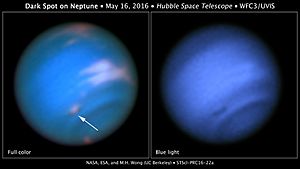Great Dark Spot facts for kids

The Great Dark Spot (also called GDS-89) was a huge storm on the planet Neptune. It looked a lot like Jupiter's famous Great Red Spot. In 1989, the NASA Voyager 2 spacecraft first saw this Great Dark Spot.
Like Jupiter's spot, these are giant spinning storms called anticyclonic storms. But unlike Jupiter's spot, which lasts for hundreds of years, Neptune's dark spots don't last as long. They usually form and disappear every few years. Scientists have seen that Neptune often has a Great Dark Spot. We still don't know much about how these dark spots start, move, or disappear.
Contents
What Was the Great Dark Spot Like?
The Voyager 2 spacecraft found the Great Dark Spot in Neptune's southern half. This dark, oval-shaped storm was about the same size as Earth. It measured about 13,000 by 6,600 kilometers (8,100 by 4,100 miles).
One big difference from Jupiter's Great Red Spot is that Neptune's spot could move north and south. Jupiter's spot stays in one area because of strong winds. Around the edges of Neptune's storm, winds blew at an amazing 2,100 kilometers per hour (1,300 mph). These are the fastest winds ever recorded in our Solar System.
Scientists think the Great Dark Spot was a hole in Neptune's methane cloud layer. The spot was seen with different sizes and shapes at different times.
The Great Dark Spot also created large white clouds. These clouds were like the high-up cirrus clouds we see on Earth. But Neptune's clouds are made of frozen methane crystals, not water ice. These clouds were very high, about 50 to 100 kilometers (30 to 60 miles) above the main clouds. On Earth, cirrus clouds usually disappear in a few hours. But the clouds near the Great Dark Spot stayed for more than 36 hours. That's two full rotations of Neptune!
Neptune's dark spots are thought to be lower down in the atmosphere. They are stable and can last for several months. This makes scientists believe they are like giant spinning whirlpools of gas.
Where Did the Great Dark Spot Go?
In November 1994, the Hubble Space Telescope tried to photograph the spot again. But it was completely gone! This made astronomers think it had either disappeared or was covered up.
Sometimes, even if a dark spot isn't visible, it might still exist as a storm. This is because its companion clouds can still be seen. Dark spots might disappear if they move too close to Neptune's equator. Other unknown things might also make them vanish.
Other Dark Spots on Neptune
After the first Great Dark Spot, scientists have seen several others. In 1989, when Voyager 2 saw the Great Dark Spot (GDS), it also found a second dark spot, called Dark Spot 2 (DS2). This second spot disappeared before 1994.
Since 1994, the Hubble Space Telescope has been the only way to see dark spots on Neptune. Hubble can take pictures in blue light, which is how these features become visible.
- In 1994, a Northern Dark Spot (NGDS-1994) formed in Neptune's northern half. It disappeared between 1998 and 2000. This storm stayed in one latitude during its time.
- In 1996, another Northern Dark Spot (NGDS-1996) appeared. It was seen until it vanished before 1998. This one also didn't move much north or south.
- In 2015, the Hubble Space Telescope found a Southern Dark Spot (SDS). This spot moved towards the pole before it disappeared in 2017.
- In 2016, a new spot appeared in Neptune's northern half. It looked almost exactly like the original Great Dark Spot (GDS). This new spot, called the Northern Great Dark Spot (NGDS), has been visible for several years. We don't know if it's still there, as Hubble observations are limited.
More recently, in 2018, a new main dark spot and a smaller one were found. This was exciting because it was the first time Hubble could watch a dark spot form from the beginning. This storm was smaller than the one Voyager 2 saw. But it was still huge, wider than the Atlantic Ocean, at about 4,600 miles across.
In August 2020, this new Great Dark Spot suddenly stopped moving south. It even started moving in the opposite direction! Scientists thought it would keep going to the equator and disappear. Storms might stay stable in the northern half because of something called Coriolis force. But as storms move towards the equator, this force gets weaker, which can make them disappear.
Around the same time, a smaller "Dark Spot Jr." was found near the larger storm. It later disappeared. Dark Spot Jr. was about 3,900 miles wide. Scientists think the larger storm's change in direction might be connected to the birth of this smaller storm.
Scientists are still studying how these storms form. But observations show that dark spots often appear after an increase in cloud activity in that area. This happens about 2-3 years before the spot becomes visible. The storms seen from 1989 to 2018 have moved in different ways. They usually only stay visible for a few years. Also, dark spots might disappear when companion clouds reach the center of the storm. These clouds can block the blue light used to track the storm, making it seem to vanish.
Future Missions to Neptune
Two ideas for missions to Neptune have been suggested to NASA.
- Trident was proposed in 2021. It would visit Neptune and its moon Triton. However, two missions to Venus were chosen instead.
- Neptune Odyssey is another idea for a large orbiter mission. It has similar goals to Trident and might launch around 2033.
These missions mainly want to learn more about Neptune's largest moon, Triton. But they also aim to gather more information about Neptune's atmosphere. New discoveries about Neptune's atmosphere could help explain how the dark spots on the planet form.
See also
 In Spanish: Gran Mancha Oscura de Neptuno para niños
In Spanish: Gran Mancha Oscura de Neptuno para niños
- Dragon Storm (astronomy)
- Extraterrestrial cyclone
- Great Red Spot, a similar storm on Jupiter
- Great White Spot, a similar storm on Saturn
- Oval BA
- Small Dark Spot
- Hypercane


